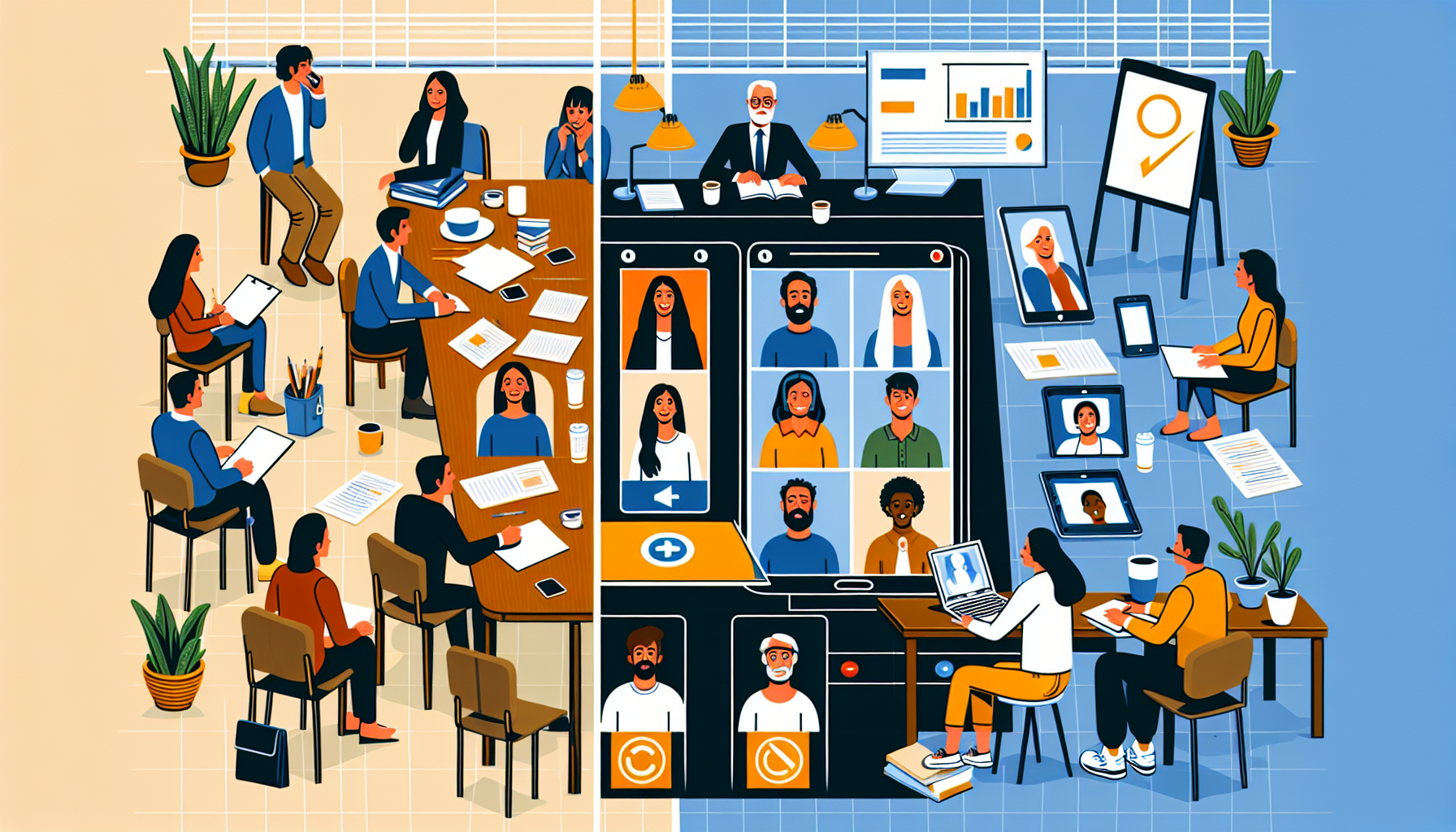The Battle of Focus Groups: Online vs. In-person – Which Reigns Supreme?

Oh, the age-old debate of online vs. in-person focus groups. It’s like choosing between a mountain hike and a beach vacation. Both have their unique charm, but the choice ultimately depends on your taste, doesn’t it? Well, not quite. When it comes to focus groups, the choice isn’t as simple as picking between the exhilarating mountain air and the soothing beach waves. It’s about understanding the nuances, weighing the pros and cons, and making an informed decision. If you’re still wondering which is better, then this can help you:
Virtual vs. Reality: The Great Debate
A focus group, whether online or in-person, is a common methodology used in market research. It involves a small group of people coming together to share needs, preferences, opinions, and experiences about a specific product or service. The facilitator of the discussion, known as the moderator, leads the discussion with the goal of gaining insight for the company through spoken feedback of consumers and potentially B2B professionals.
Typically, in-person focus groups are held at a brick and mortar location, often a focus group facility, where the participants and moderator are allocated a room to conduct the discussion panel. However, with the advent of technology, online focus groups have emerged as a viable alternative, leading brands to consider this option.
Pros of Traditional Focus Groups
Jumping into a focus group as a volunteer is like getting a backstage pass to the product development party. It’s all about sharing your thoughts in a laid-back setting and having your say in how things should roll out. Picture this: you’re in a room with others, shooting the breeze about a product or service. The cool part? Your insights can actually tweak the marketing or fine-tune the product before it hits the big stage.
Being part of a focus group isn’t just about voicing your opinions; it’s about teaming up with others to cook up ideas that brands can sink their teeth into. The vibe is collaborative, and with a moderator stirring the conversation, it’s like having a chat with friends – but with a bit more purpose.
Now, let’s talk perks for the volunteers. You’re not just a fly on the wall; you’re a trendsetter, influencing how things unfold. Your early feedback can shape the destiny of a product, and being in the loop before everyone else gives you that VIP feeling. Plus, there’s something cool about being part of the behind-the-scenes crew, helping steer the ship.
Cons of Traditional Focus Groups
Now, let’s spill the tea on the not-so-cool parts of traditional focus groups. Brace yourself, because when it comes to cons, there’s a bit more to consider.
First up, the moolah. Traditional focus groups can put a dent in the budget with all those specific fees flying around. Think renting a focus group facility, recording fees, audio files – oh, and don’t forget about the parking, meals, and beverages. It’s like a hidden expense party that participants might not even know they’re attending.
And let’s talk about the time and travel commitment. It’s not just a quick hop, skip, and jump. Participants might need to clear their schedule, pack a bag, and hit the road. That’s a lot to ask, and, let’s be real, it’s not everyone’s cup of tea. Some might see it as a total buzzkill and decide to pass on the whole focus group shindig.
Now, here’s a kicker – the location factor. In-person focus groups practically scream “local talent only.” If you don’t live or work nearby, you might miss out on the chance to join the party. This geographical restriction can limit the diversity of participants, and brands might end up with a one-sided view instead of the full picture.
So, while traditional focus groups have their perks, they’re not exactly a walk in the park. Budget hurdles, time commitments, and location constraints can throw a wrench in the plans, making the cons something to seriously ponder.
The Growth and Globalization of Technology
Picture this: You’re not bound by the walls of a traditional focus group facility anymore. Nope, you can dive into the world of market insights from the comfort of your own couch. Online focus groups are like the virtual rockstars of market research, shaking things up with user-friendly platforms that practically hold your hand through the process. And the best part? You don’t need to break the bank with fancy memberships; it’s like getting VIP access without the hefty price tag.
Now, reaching participants is as easy as sending a message. No need to worry about geographical constraints or scheduling nightmares. With a few clicks, you can assemble a diverse group of voices from different corners of the world, all sharing their thoughts on your product or service.
But hold on, we’re not done yet. The rise of online focus groups isn’t just about convenience; it’s a game-changer for inclusivity. Anyone with an internet connection can join the party, making market research more democratic than ever. It’s like breaking down barriers and letting everyone have a seat at the table.
Pros of Online Focus Groups
Online platforms are like the thrift shops of market research – budget-friendly and cost-effective. No need to break the bank on fancy focus group facilities; just fire up your device, and you’re good to go. It’s like getting the same VIP access but with a significantly smaller dent in your wallet.
But the real game-changer? Location, or rather, the lack of it as a hurdle. Picture this: You can be sipping coffee in Paris, enjoying tacos in Mexico, or lounging on a beach in Bali – and still be part of a focus group. The magic word here is flexibility. As long as you’ve got Wi-Fi, you’re in. No more worrying about missing out just because you’re not in the right city. It’s a global party, and everyone’s invited.
Now, let’s talk about breaking down borders. Online focus groups are like the jet-setters of market research. Global companies, meet your global consumers – all in one virtual room. No need for multiple focus groups in different cities; it’s a one-stop-shop for gathering insights from around the world. It’s like having a global representation of your ideal client without the hassle of jet lag or multiple time zones.
So, for volunteers, joining an online focus group isn’t just about giving feedback; it’s about doing it from the comfort of your favorite spot, without burning a hole in your pocket, and being part of a truly global conversation. Talk about a win-win situation!
Cons of Online Focus Groups
Now, let’s shine a light on the flip side for volunteers in the realm of online focus groups. It’s not all sunshine and rainbows, and here’s the lowdown on the drawbacks:
First off, we’ve got the absence of that face-to-face magic. Without being physically present in a live room, the moderator might miss out on those subtle non-verbal cues – you know, the nods, frowns, and raised eyebrows that speak volumes without saying a word. It’s like trying to read a room through a screen; you might catch some vibes, but it’s not the same as being there in the flesh.
And let’s talk interaction – or the lack of it. Online focus groups, while convenient, can be a bit like attending a virtual party where everyone’s on mute. Participants might find it trickier to spark spontaneous side-discussions or chime in with those golden nuggets of unprompted insight. It’s like missing out on the impromptu brainstorming that often happens in the lively atmosphere of face-to-face sessions.
Now, let’s tackle the language hurdle. Working with a multicultural group representing a global market is fantastic in theory, but in practice, it can hit a roadblock – language barriers. Online interviews might turn into a linguistic maze, with participants navigating through different accents, expressions, and communication styles. It’s like trying to bridge the gap when the bridge is made of language hurdles.
So, for volunteers, while online focus groups offer convenience and global reach, there’s a trade-off. Less non-verbal cues, subdued interaction, and potential language hiccups might make the online experience feel a tad less vibrant than its in-person counterpart. It’s the classic case of weighing the pros and cons in the world of market research adventures.
Face-to-Face Feud vs. Online Odyssey
Alright, let’s break it down in plain talk. Face-to-face vibes always pack a punch, but let’s face it, tech has flipped the marketplace on its head in the last couple of decades. Focus groups are still the MVPs of market research, no doubt, but you can’t ignore the buzz around online focus groups these days. Every organization’s got to weigh the pros and cons of both worlds.
If you’re running a mom-and-pop shop or a midsize gig with a local fan base, those in-person focus groups might be calling your name. There’s something about the live chat vibe that clicks, you know? On the flip side, if you’re a big shot with a global footprint, online focus groups might be more your speed. It’s like a choose-your-own-adventure, tailored to fit the size of your business shoes.
Now, here’s the real head-scratcher: Is tech and the online focus group wave gonna knock out the old-school face-to-face gig? Cue the suspense music, ’cause only time’s got the answer to that one. We’re all just riding the market research rollercoaster, waiting to see which twist and turn it takes next.






